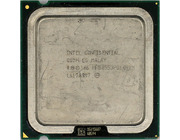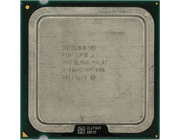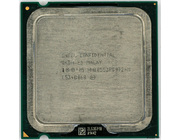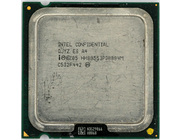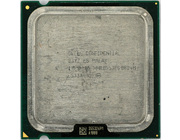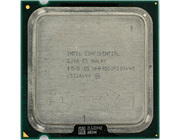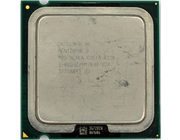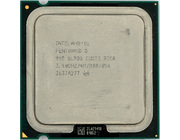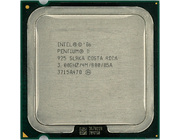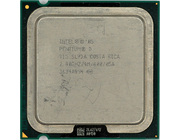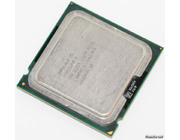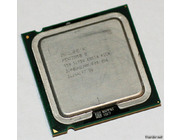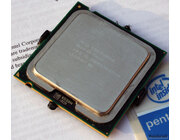The successor of the 'Smithfield' core. Intel used two 65nm 'Cedar Mill'-cores (successor of 'Prescott') in order to create the Pentium D 'Presler'. Basically Intel did exactly the same before with the 'Smithfield' by gluing two 90nm 'Prescott' together.
A big advantage for Intel was that 'Presler' had two seperate dies, where 'Smithfield' has one large die. If there is one failure in one part 'Smithfield' core then everything can be thrown away. In case of 'Presler', Intel only have to dispatch 50%.
Identical to this Pentium D 925. Somewhere on the lines I ended up with two of these CPU's.
The 65nm 'Presler' CPU succeeded the 90nm 'Smithfield' CPU. It ran cooler and could be clocked higher a bit. In reality it is a dual Pentium 4 and in the time-frame when this CPU was made (33th week of 2007) I don't really see a reason why someone would invest in an outdated Pentium D unless the price was (really, really) sharp. Remember that the Core 2 Duo was out for a year at this point ![]() . > Read more
. > Read more
In most cases the Pentium D 945 is equal to the Pentium D 950. They share the same core, run at the same clock-frequency and have the same cache configuration. The only exception is that the 950 has virtualization technology enabled which is an unnecessary feature for most desktop users.
The reason why Intel brought both the 945 and 950 to the market is unknown to me. I think that the introduction of the 9x5 models without virtualization only made the product list more complicated and thus would confuse customers. > Read more
Just like the Pentium D 915 but 200MHz faster. > Read more
Intel released a cheaper version of the Pentium D; the 9x5-series. These CPU's are identical to the normal versions except that these don't have virtualization technology activated.
The D915 is like the D920 but without VT, the D925 is like the D930 without VT, and so on. > Read more
Second fastest Pentium D running at 3.4GHz. Introduced early 2006 as high-end CPU just before the Core 2 Duo made it's debut in the summer of 2006. The fastest Pentium D is the 960 at 3.6GHz. The 955 and 965 use the same core but go under the flag 'Pentium Extreme Edition'. > Read more
An 65nm dual-core 'Netburst' engineering sample with CPUID 0F62h and speedstep bug. In other words: B1 stepping of the Pentium D 920.
This Intel Confidential QKDH got me on the LGA775 track for a while. I obtained this sample at the time when the Intel Pentium D 930 and AMD Athlon64 X2 3800+ were a good deal with around 200 euro. This sample was a cheaper than both so I switched to LGA775. Because of upgrading and putting my 'old' desktop hardware in the home server I bought other LGA775 parts. This QKDH is the first LGA775 CPU, first Netburst CPU, first dual-core and first Intel Confidential I obtained.
Many people think that engineering samples are good for overclocking. This processor is the perfect example for that because this one is far from a good overclocker. For 24/7 work it only gets to 3600MHz which is peanuts, with good cooling, for practically any other 90nm or 65nm retail model! Another sidenote: multipliers are not always unlocked on engineering samples. Most samples can only lower in multiplier which is common for retail CPU's as well due to energy saving techniques like Powernow! and Speedstep. > Read more
